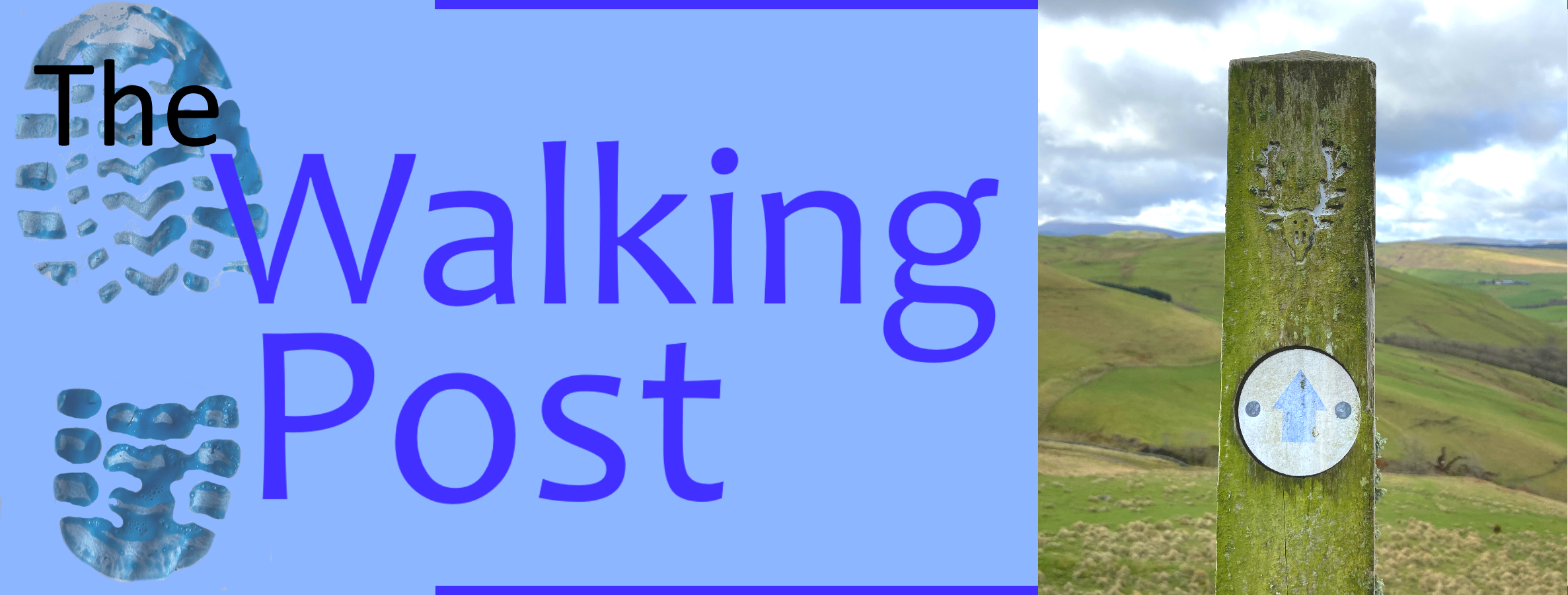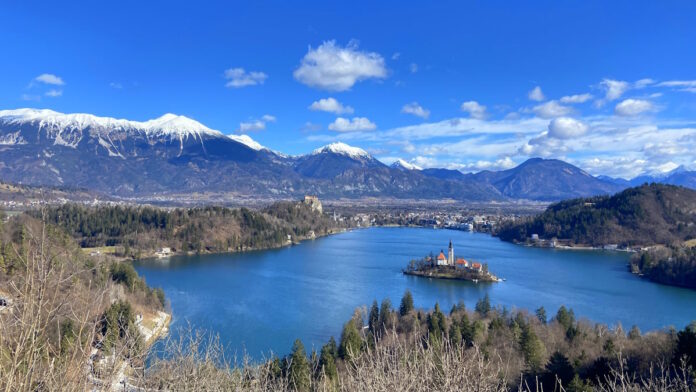I recently visited the Slovenian capital of Ljubljana for a trade show. As I often do, it was an opportunity to explore the city and its surroundings.
The prime time for events, regardless of the subject, is pretty much late January to June, with July and August very under-represented. Things then kick off again in September, until mid-December.
This means that, in Europe, you’re generally visiting places in the seasons when tourism is at its lowest ebb. This can be both a good thing – for example places are less crowded and flights cost less, or a bad thing – the weather may not comply, and attractions may be either closed or on reduced hours.
I thought of just writing this about walking around Ljubljana, but then figured it might be more helpful if I made some observations to encourage others looking for different destinations, which might include a visit to a corner of Europe that is often ignored, at least by British tourists.
So, the first question – should I visit Ljubljana? The answer comes with a caveat – yes, but. Yes, Ljubljana is a good place to visit, but it’s not like other capital cities. Notably, it’s small. So, if wandering around cities is your idea of a great few days, you’ll comfortably be able to see pretty much all there is to see in Ljubljana in an afternoon. Or, a morning, if you’re up early. You could extend that by an hour or so if you sit and have a coffee at one of the many cafes, but even this comes with a warning. If you’re a non-smoker, you won’t be outside enjoying the views, as there’s a veritable cloud of smoke hanging over ever outdoor seating area. If I didn’t know better, I’d say it was a local law that to sit outside, smoking is compulsory.
In spite of its relatively small size, it would be a mistake to dismiss the city. If you were to plan a week in the country, you could easily come up with an itinerary that spends a little time in the capital, and also explore what is around the former Yugoslavian state. The country is pretty small, too.
Getting there
First, let’s look at getting there, at least from the UK. Ljubljana isn’t the easiest of places to get to by plane. It almost always involves a stopover, in my case, this was Zürich in Switzerland.
Most airlines serving the country don’t do so daily, so when checking on prices, it’s sensible to check two days either side of your preferred dates of travel. If you can be flexible, you can save a lot just by picking a different day. My initial intent was to travel on a Saturday and come back on a Friday. The estimates came in at around £600. However, by flying out on Friday and returning on Thursday, this dropped to £308. It also makes sense to check out different airlines, and to be aware that what may be a cheap flight might not include carry-on baggage. So, shop around.
Getting ready
Next, a little about preparing for your trip. I was in Sweden twice last year, and the first time, I exchanged some currency, just in case. It’s always useful for things like markets or street food. Well, not in Malmö. Not only did market vendors take cards, I didn’t find one that took cash. So, I returned with all my Swedish currency crisply unused. And promptly lost money changing it back to pounds.
Slovenia is a different story. It’s very much a cash country, although it’s useful that we’re talking Euros. I was surprised by the number of places I went where it was cash only. Even the main bus station in Ljubljana only took cash, and the cash machine in the bus station charges a mere €6.99 fee for a withdrawal. If you didn’t bring Euros, or you need to get some – there’s a bank right opposite the bus station where the fee is only whatever the exchange rate is. Bank cash machines tend to not have the exorbitant fees, and there are plenty of banks around.
Getting around the city
Local buses (LPP) don’t take cash, but then they don’t take debit cards, either. You need to get a travel card, called the Urbana card, available for €2 at many places around the bus station. You then top up with money to pay for buses. The rides are cheap enough, anywhere in the city centre is €1.30 and there are only three zones, so don’t get a card, load it with €30 and then not use most of it. If you buy the €2 card from a tourist information office and keep the receipt, they will refund you the €2 when you leave if you take it back.
The bus from the very small airport to the city can take 45 minutes to 1 hour and 15 minutes, depending on if it’s direct or passing through all the villages, which personally I like, because you get to see more. Actually, I didn’t see much, because it was tipping it down when I arrived, so all I could see was cloud and rain running down the windows. It was as if Ljubljana and its surrounding area was as flat as a pancake. Which, once the rain cleared two days later, is completely inaccurate. The city is surrounded by high mountains (the Alps), which, given I visited in February, were snow covered and beautiful.
But, back to the bus. From the airport, the cost is currently €3.70, and they DO take cash. And they give change. And the driver I had spoke English reasonably well.
I always recommend people to try and learn at least a few words of the language if at all possible. When he gave me the ticket and I replied with hvala, or thanks, he beamed. He did drive like a maniac into the city, driving about 18 inches behind whatever vehicle was in front, regardless of the speed limit. But he was pleasant and there were no collisions. I did witness a couple of accidents later in the week, however, both caused by tailgating, one of which involved two bicycles.
At this point, I should mention that while public transport is cheap in Slovenia, it’s sporadic. There is not a bus from the airport to the city every 20 minutes. There are times when the wait is longer than an hour. For the impatient, or those on a schedule, there are minibuses that will take you straight to the city for €12.50. But I was happy to save some money, and it was early afternoon, and I wasn’t likely to be doing much exploring given the weather. Perhaps at 10pm, I’d have gone with the minibus. I also wouldn’t have wanted to spend much more than an hour on the buses, as the seats are extremely close together. Had someone sat in the seat in front, if the seat moved my knees would have become earmuffs.
There are lots of buses around the city, but getting around the country, the same issue of timing arises. Buses and trains to nearby cities aren’t that frequent either. Cheap, but not frequent. So, if you’re basing yourself in Ljubljana and taking day trips by public transport, please check what time the return journey will be. There might not be one. Or it might have already left before you arrive.
Flixbus does operate in the city to get you further afield, but again, check the timetables.
Another tip – if you are in Ljubljana on a Sunday, have something to do. Some restaurants open, but by no means all of them. All supermarkets are closed. Most shops are closed. Some of the main streets, which are pedestrianised, were eerily deserted even at noon.
Walking around Ljubljana
I decided that, given everything was shut, this would be a good day for a walk within Ljubljana. Disappointingly, the weather was still horrendous, so by the time I reached the top of the hill overlooking the city, with its castle, I was soaked. And the view was of clouds in all directions. On a clear day, the view of the city below with mountains in the distance is spectacular. The one positive was there were no leaves on the trees, so the view, such as it was, was easier to see.
The castle – which is a modern reproduction if you’re expecting history – is just the beginning of many miles of paths in a park that extends southeast for just under a mile. This may not seem like much, but there are so many trails you could easily spend an afternoon there. What’s equally good is that Ljubljana is surrounded by parks and woodland, so when you do get to the end of the trails and the main road at the end of it, you can cross the road and be in an even bigger forest that extends for, well, days if you wanted to.
I don’t think Slovenians are particularly insular, because occasionally they will say hello (in English or Slovenian) if you do first, but most of the people I walked by avoided speaking or even making eye contact.
But Slovenians, it seems, do love to walk. Whenever I went out, there were lots of locals walking as well. Unlike rural Scotland, where I can walk all day and not see a soul, around Ljubljana there was always someone nearby. So, also bear that in mind if you need to relieve yourself by a tree. You’re never alone.
Another park that lies very close to the city on the northeast side is Park Tivoli. It’s one of those parks that, when you first go in, looks like any other park in a city in Europe. There are sports facilities, a few cafes, some neat gardens, and a large stately home with a boulevard leading up to it.

But this is just the portion close to the city centre. Venture beyond this more formal part, and you’re into some hilly, wooded paths that go on for hours. You can stay close to the city, or you can keep going, eventually looping back to the city. In all, there are dozens of well-marked trails, and the park extends for more than 2.5 miles westward. There are viewpoints, again with views of the mountains, there are one or two cafés, some buildings, streams, and small ponds; enough to keep you going for an entire day. As with the castle park, if you do reach the outer perimeter, it’s not the end of the path, there are more forests, more hills, and hundreds more trails. It would take more than a day, but you could keep going and wind up in Italy. You’d also be very tired.
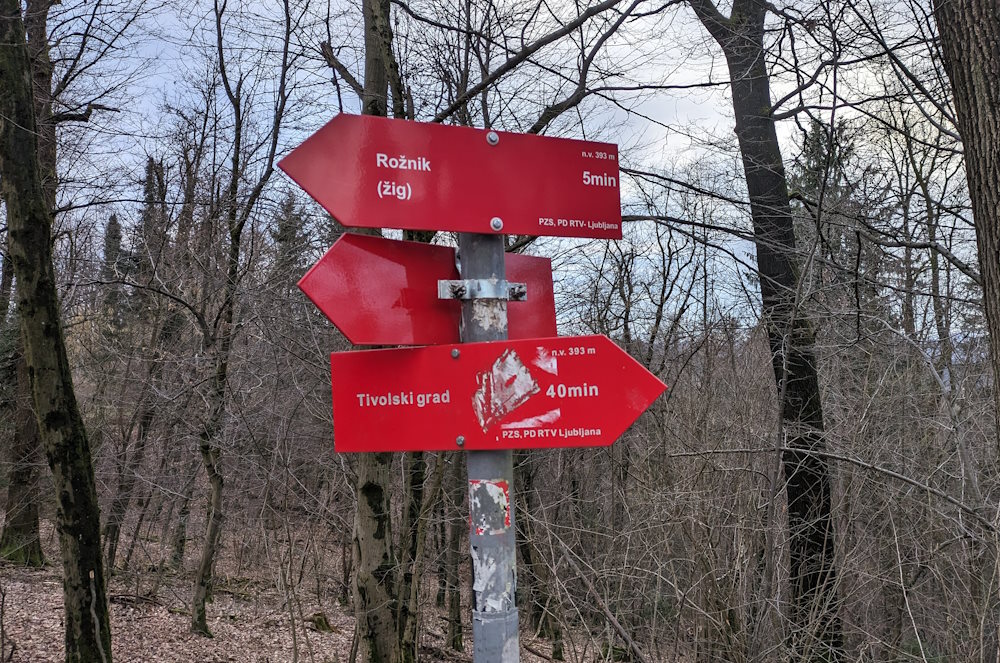
While the trails are all well marked, and do appear on your phone maps, it’s important to bear in mind that because of the hilly terrain, what looks like a path on your map may not be the right one.
Often, there are trails on different parts of slopes, heading in different directions, so do keep an eye out for which direction you are actually walking. Apps like Komoot are useful for following trails that have been done before, but even then, you may find yourself on the wrong path because there’s another one slightly higher up running parallel, or you may be on a path that doesn’t look very official and you’re scrambling through tricky undergrowth. But, walking from, and around, Tivoli, should provide you with another half to a full day of interesting hiking.
Another positive about Slovenia is that, because you’re in a much different part of Europe, the flowers and birds can be relatively unfamiliar too, which I find makes things interesting, having to look them up online with such scientifically-accurate queries as ‘big duck with purple head.’ And no, it’s not called Big-headed purple duck. It was a rare kind of mallard. Apparently.
Other trips
You could rent a vehicle and drive to other parts of the country. Renting a car isn’t that expensive, although it does mean you have the added hassles of filling up the tank during and at the end of the rental, dealing with road signs, and dealing with often confusing parking rules. And sometimes, tolls. But it’s an option, given the public transport options aren’t perfect. And, it gives you an opportunity to bag other countries, if that’s something you like to do.
From Ljubljana, by car, you can reach:
Trieste, Italy – 1 hour
Zagreb (the capital) or Rijeka (on the coast) in Croatia – 1 hour 40 minutes
Klagenfurt, Austria – 1 hour 20 minutes
Vienna, Austria – 4 hours
Brno, Czechia – 5 hours 20 minutes
Bratislava, Slovakia – 4 hours 20 minutes
Keszthely, Hungary – 3 hours
Bihac, Bosnia and Herzegovina – 3 hours 30 minutes.
So, from your hotel in Ljubljana, a couple of day trips can give you trips to eight countries (including Slovenia). Of course, you need to negotiate borders, several different currencies, different languages, toll roads, and different driving regulations, but the good news is most rental companies – as long as you let them know you’re leaving Slovenia – don’t have a problem with you leaving Slovenia. Given how small it is, they likely expect it. Just communicate with them first and ask about paying for tolls, crossing borders, etc. As it’s a small country surrounded by others, they are quite knowledgeable about what to do.
Of course, you don’t need to leave Slovenia. It bills itself as the Sunny Side of the Alps, and so if you are looking for great walks, you could spend a month in Slovenia.
There are several long-distance trails in Slovenia. Some of these are parts of much longer trails across Europe. Regardless, all of them will take you at least 10 days. All of them feature climbs, and all have stunning scenery.
Day trips
Ljubljana, while not a major hub in terms of frequent buses and trains, does still lend itself to being a base for some great day trips.
One of the most beautiful places in Europe has to be Lake Bled, and it’s a mere €5.70 bus ride and one hour away from Ljubljana. Again, bus times aren’t regular, and the times are, I’ve found, estimates. The 3:30 bus from Bled back to Ljubljana arrived at the bus stop at 3:38, and left around 3:46, followed by a two-minute conversation with another bus driver through their respective windows.
In fact, times everywhere should be taken as a guide only. I stood outside one store in the city – which allegedly opened at 10 – until 10:05, when two young women rolled up, opened the door, went in, locked it again, opened it at 10:07, and locked it again while they smoked a joint outside. I gave up. Maybe it’s still closed.
What was great, though, was the fact that I asked if the bus made stops in Ljubljana on the way back or just at the station, and the driver asked where I was headed, and dropped me off right at the top of the street of the place I was staying. Helpful. And not something I can imagine the driver doing around here. They’d probably be fired for not stopping at a proper bus stop.
Bled is massively tourist oriented. Even in February, it was filled with people and tourist buses. I can’t even imagine July.
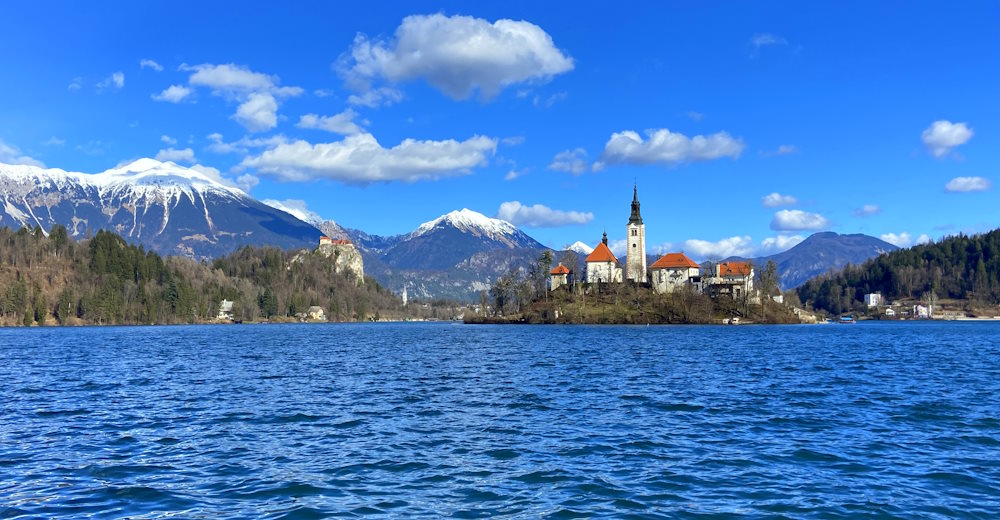
While they are quite happy to take tourists’ money with overpriced souvenirs and eye-watering restaurant prices, they aren’t so happy for you to do other things. The number of ‘do not’ signs was astonishing. And here are just a few of them I spotted by the lake: DO NOT – walk on the grass, have picnics (with an added ‘k’), swim in the lake, rollerblade, play football, camp, light a fire, drive a car, scooter, bike or skateboard, paddleboard, leave litter, bring a dog, or sunbathe. Spending money is ok, though. There is even a pyramid diagram of priorities, with cars at the bottom and us good old hikers at the top. The hikers in the diagram have poles and backpacks, which presumably are among the few things allowed. Unless said backpack contains either a lunch, rollerblades or a dog.
There are some higher buildings around the resort part of Bled, so it’s quite possible there are snipers on the roofs, ready to punish any minor transgression. I didn’t transgress.
I had initially planned to do the hike around the entire perimeter of Lake Bled, but even that had restrictions. I was told at the tourist bureau that there was a stretch of path that was closed as they were preparing it for tourists (the summer ones that, presumably, spend more money than us springtime losers), and that if you tried to go across it, you’d get a €160 fine. You could walk around through the villages, but that would add a couple of hours, for a 200-yard detour. I decided to reverse my walk, go around most of the lake, and then go up to the viewpoints above the lake, before heading back the same way.
One great advantage of walking in February is that the mountains were still snow-capped, adding a magical backdrop to the walk at all times. Other advantages were that the temperature was only 10, and that there weren’t thousands of people around, although there was no point during the hike that I was even close to alone. And I don’t mean the presence of big brother looking to hand out fines.
The signposts were, again, excellent and frequent. And the scenery breathtaking. The views following the very steep climbs up the hills at the end of the lake were breathtaking in other ways, too. There are even places where the path is about 18 inches wide with a sheer drop off the other side, and a cable to hang on to as you scramble across the uneven rocks, some of which have metal footholds banged into them to make it slightly easier.
I may have not bothered with one of these hilltop detours, had it not been for a clearly unfit couple with inappropriate footwear, who said the view was amazing. And I figured, if they could do it, I could. It was a little nerve wracking, but they were right, the view from the top, above the treeline, was phenomenal.
At the top of the next hill, an equally-challenging haul, the view was almost as good. Of course, there were several people there, enjoying the Slovenian national pastime of smoking. It’s probably why, in Bled, no smoking was not one of the signs. There would be a revolution. So, once I’d inhaled the local pollution from a woman who was also coughing uncontrollably and clearly not making the connection, and after I’d taken a few hasty photos, I left. Perhaps the smokers are paid by the government to prevent people lingering at the top and having an illegal picnic(k).
The descent was quite tricky, and being February, there was nowhere along the route to get a drink, so I had to wait until I got back into Bled. But the entire day was more than worthwhile, and definitely a ‘highlight’ day trip. Even with way more people in the summer, and with higher temperatures, this would still be a fantastic place for a hike. Also, there are plenty of other side hikes from around the perimeter of the lake. I assume like most places, the further you get from the town and its restaurants, and from parking, the less people you’re going to see.
If you’re staying in the area for a night, you could do a lot worse than head to the hills near Zasip, a village about 1 mile (1.5 km) north of Bled, where there are some spectacular hills, valleys, gorges and waterfalls. This area is the eastern end of the Triglav National Park, where, again, you could spend a week alone doing hikes in the mountains. Good options include Mostnica gorge and Lake Bohinj, although for this you will need your own transport. There are also plenty of mountains here in excess of 2,500m, almost twice the height of Ben Nevis. So, not an afternoon stroll.
The entire area, close to the borders of Austria and Italy, has some spectacular scenery, with gorges, blue-green rivers, waterfalls, and pretty Alpine villages, like Kranjska Gora, a winter skiing resort that resembles the quaint Austrian villages just across the border.
Postojna
Tourists often make a beeline for the caves at Postojna. The good news is it’s also close to Ljubljana and can be reached easily by public transport. The caves aren’t cheap to visit, and while definitely worth seeing, there are dozens of hikes around the area as well. As Bled sits on the edge of a larger park, so does Postojna, as it is the gateway to the Krajinski Park. This has scores of mountains ranging from about 500m to 1,200m, so a little lower than around Bled, but some of them are just as challenging.
The caves, should you choose to visit them, will take up a few hours, and you could easily spend a night here (not in the caves), seeing the caves and doing a day-long hike in the hills. You could do 20 day-long hikes in the hills, but if you want to see the entire country and what it has to offer, then you’ll have to move on.
Border walks – Croatia
If you like the idea of being in two countries at once, or close to it, then the Slovenian border with Croatia has some interesting options. There is a massive national park on the Croatian side, the Park Prirode Žumberak-Samoborkso Gorje. The downside is it’s really a bit of a trek to get there. If you’ve rented a car, you can get to the nearest city, Otočec, in about 45 minutes. Or 30 if my airport bus driver is behind you. Otočec is a small place, and only about 6 miles from the border with Croatia, but those border hikes are a little trickier to get to.
Also, be aware that the border crossings between the two countries – in spite of them both being in the EU – sometimes require you to provide ID, so if you’re crossing between the two, take your passport along just in case. Reading about the border issues between Croatia and Slovenia make for fascinating reading – there are still bits of both countries claimed by the other – issues primarily created by the dissolution of Yugoslavia at the end of the last century.
Border walks – Hungary
There’s another national park on the other side of another border, this time Hungary. Őrségi National Park also has some worthwhile walking, including one where you may well see European bison.
The difference between doing your own thing (car) and public transport is really highlighted here. If you’re in a rental car, you can get to the nearest town, Turnišče, with a population of just 1,500, in under two hours. By public transport? More than nine.
While the national park is an option, it’s not the only one close to the border. Lake Balaton, which is about 50km long, has some great walks, which you can explore using Keszthely as your base. The city of just over 20,000 is also worth a visit, but the lake is the biggest attraction, with walks all around its perimeter.
Border walks – Austria
If you have a vehicle, the sky’s the limit – Austria is one of the best hiking countries around. There are options everywhere, near Graz and Klagenfurt, just for starters.
However, if you’re relying on public transport, you could do far worse than heading to Villach, less than 1.5 hours from Ljubljana, where there are some great walks. The town itself is pretty, but if you want something different, take a bus to the beginning of the Ossiacher See, where there are walks along the lake, as well as the opportunity to head up into the side of the mountains on the south side, up and around Burg Landskron, where you will get stunning views of the lake and Villach, and back into Slovenia. There are lots of lakes and rivers to explore in the area, meaning Villach and the Klagenfurt area are easily worth a week’s holiday on their own.
Other Slovenian cities
Once you’re out of Ljubljana, there are two other main cities in Slovenia: Cejle and Maribor.
Celje, the closer of the two, has a population of less than 40,000, and it’s quite pretty. It’s also less than an hour from the capital by car, and just over an hour by public transport, so another place to go to with plenty of walking options. There’s the city itself, which makes a change from Ljubljana, but there are two good walks from the city. One takes in the river, and the Savinja Suspension Bridge as well as a couple of small hills. It’s relatively short, at 5.5 miles, and has a rise in elevation of just 300 feet. So, not overly taxing.
The other option is the Grmada loop, which is just under 9 miles, with climbing of about 2,400 feet. So, much more challenging, and with some excellent views. If you’re feeling really active, you could do the river walk in the morning, have a quick light lunch, and then do the longer one in the afternoon. Or split them over two days.
Maribor, the country’s second city, is another attractive place to visit. With a population of just under 100,000, it is reachable by car or public transport in about an hour and a half. It’s also close to the Austrian border, so there are options there, too. There are walks around the city, which are worthwhile, but the best walking close to Maribor is probably toward the southwest of the city into the mountains. If you’re in a vehicle, you can drive to the bottom of the hills. If not, you can take a local bus to the southwest of the city, or just walk from the city itself, it will just add a bit of extra time – about 30 to 45 minutes – to get to the start points. One day-long walk, with a bit of climbing and some amazing scenery, including the wonderful – and wonderfully named –Framski slap-slap Skalca, will reward you with views and waterfalls, and also take you to heights of more than 3,400 feet. You’ll definitely have earned your dinner in Maribor by the side of the Drava river as you look at the scenery and inhale the second-hand smoke.
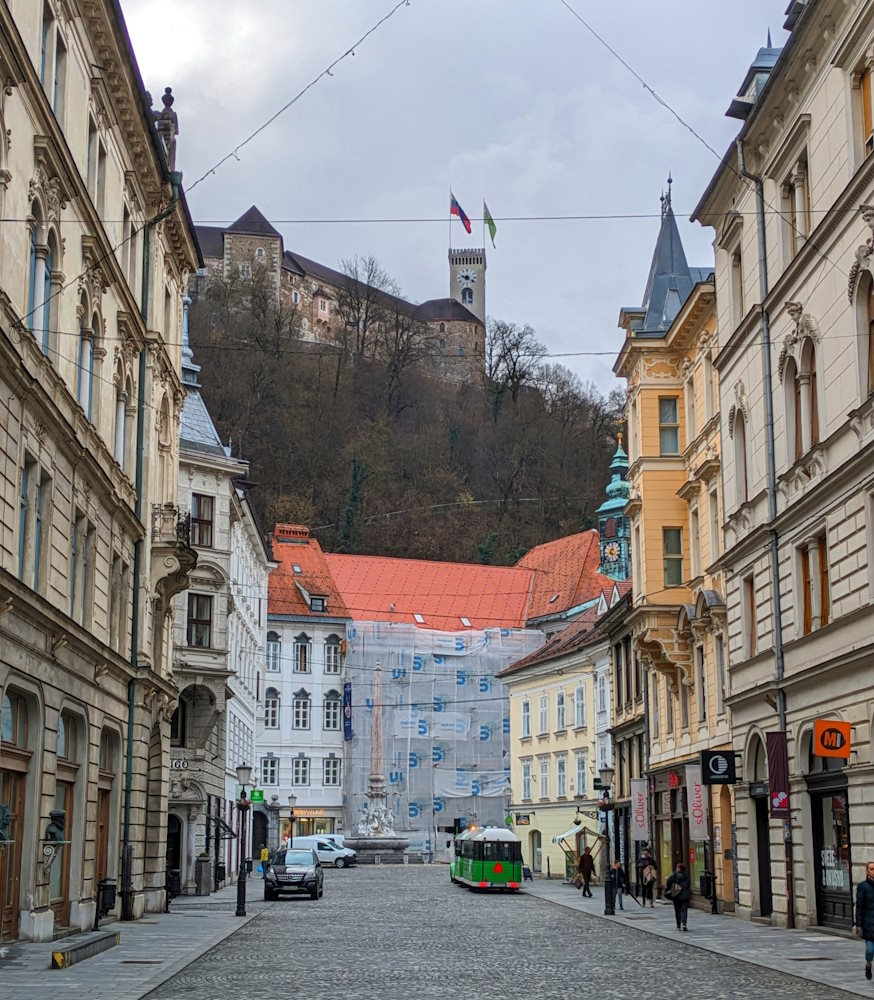
Suggested public transport itinerary for 7 days walking in Slovenia (based in Ljubljana):
Day 1: Ljubljana, Castle Park
Day 2: Ljubljana, Tivoli Park
Day 3: Bled
Day 4: Postojna
Day 5: Mirabor
Day 6: Celje
Day 7: Villach, Austria (or Kranjska Gora if you want to stay exclusively in Slovenia)
With a rented vehicle, the options expand greatly, and a week becomes a challenge because there are literally hundreds of walks within Slovenia – without even mentioning the great options just over the Austrian, Italian, Hungarian and Croatian borders.

Of course, with a vehicle, you can also plan your itinerary to spend your nights in different places, although the one disadvantage of this is that you’re packing and unpacking every single night, whereas if you’re based in one place, you can leave all your stuff in the hotel or apartment if, like me, you’re choosing a self-catering option.
The great thing is that with the relatively cheap public transport options in Slovenia, the five day-trips aren’t going to break the bank. You can always make your own packed lunches in Ljubljana if you don’t want to spend a lot of time searching for options at your destination. Just don’t have a picnic by the lake in Bled.
There are plenty of good supermarkets in Ljubljana, including Lidl, Aldi – which is called Hofer in Slovenia – Mercator, and Interspar. All have decent, and reasonably priced, vegan options, too, although clearly the bigger the store the more choices you have.
So, if you’re looking for something a little different, why not try a week of walking in Slovenia? A lot of the promotion around the country focuses on the fact the country name contains the word love (it doesn’t work so well in German or French). While perhaps a bit corny, it’s definitely apt. It’s a bit quirky, maybe as a result of the influences of many different neighbouring countries, so you’re never quite sure what to expect. The people are mostly helpful and friendly, and you’ll take a crazy number of photos.
Did I love Slovenia? Actually, yes, I’d go back again in an instant to explore more of its amazing rugged, unspoiled natural delights. Just maybe not when there are five straight days of rain. Hvala, Slovenia!
